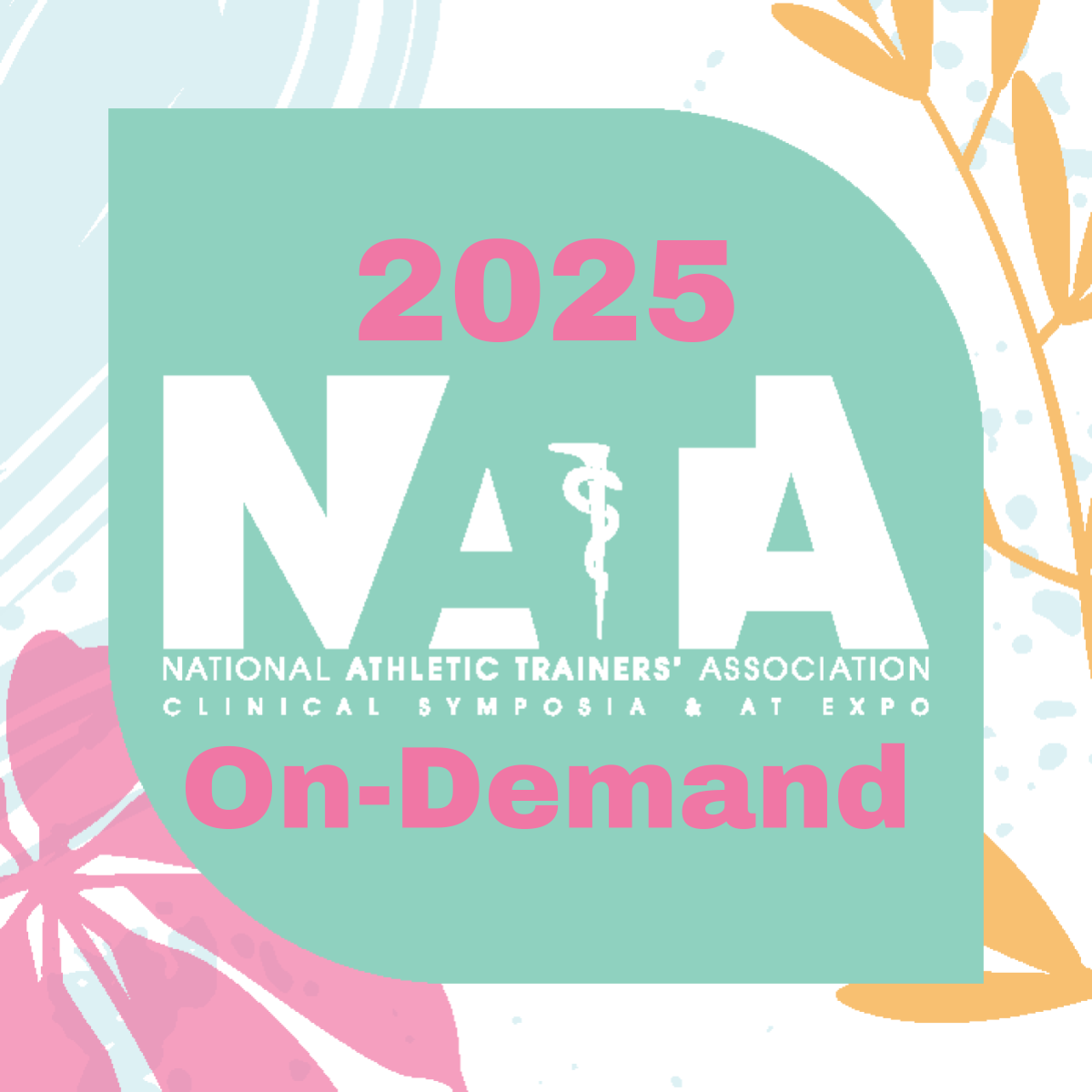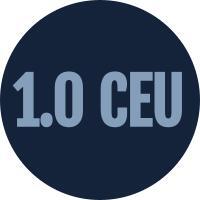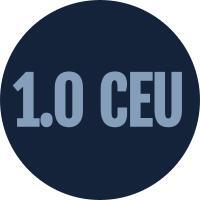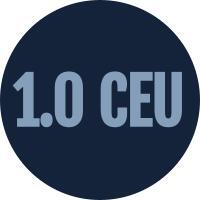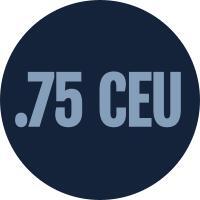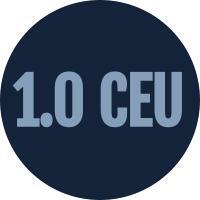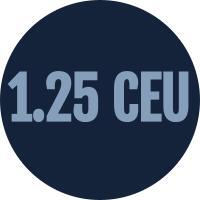

Browse Enhanced Access Catalog
All courses in the Enhanced Access On-Demand Catalog are included with NATA Membership at no additional cost! Courses are available for purchase for nonmembers.
Browse Full Catalog by Category
The Full Catalog includes ALL courses including Premium Content such as specialized content, microcredentials, and special events which require additional fees.
Course Dashboards
My Transcript
Discussions
New Courses Available:
-
Get ready for an unparalleled educational journey designed to inspire, educate and empower. This year, we are proud to present a robust program featuring the latest innovations, expert-led sessions and a variety of learning formats tailored to meet your professional development needs. Our speakers include leading experts and innovators in the field, delivering relevant and impactful content you can apply in your practice. Don’t miss this opportunity to stay at the forefront of athletic training education. The On-Demand program will feature select recorded sessions from the NATA 2025 in-person convention in Orlando, FL, taking place from June 24 to June 27. Program sessions and details are subject to change.
Welcome to the 76th NATA Clinical Symposia On-Demand Education Experience!
Get ready for an unparalleled educational journey designed to inspire, educate and empower. This year, we are proud to present a robust program featuring the latest innovations, expert-led sessions and a variety of learning formats tailored to meet your professional development needs. Our speakers include leading experts and innovators in the field, delivering relevant and impactful content you can apply in your practice. Don’t miss this opportunity to stay at the forefront of athletic training education.
Earn up to a Maximum of 20 CEUs.
On-Demand Only registrants can earn a maximum of 20 CEUs. In order to earn your CEUs, you must watch the session video in its entirety and complete the assessment.
In-person attendees can earn a maximum of 20 CEUs: Up to 15 on-site in Orlando and the rest – up to 20 total - from NATA 2025 On-Demand. In order to earn your on-demand CEUs, you must watch the session video in its entirety and complete the assessment. Interested in joining us in Orlando? View the 76th NATA Clinical Symposia & AT Expo event page.
The On-Demand program will feature select recorded sessions from the NATA 2025 in-person convention in Orlando, FL, taking place from June 24 to June 27. Program sessions and details are subject to change.-
Register
- Early bird pricing available!
- Non-member - $830
- Member - $495
- Student - $155
- Certified Student - $345
- Retired - Free!
- Regular Price after 06/24/2025 11:59 PM
- Non-member - $930
- Member - $595
- Student - $155
- Certified Student - $445
- Retired - Free!
- More Information
-
Register
-
A discussion of reduction techniques is necessary following the National Athletic Trainers’ Association Position Statement: Immediate Management of Appendicular Joint Dislocations, which clarified their potential use in clinical practice. These techniques have not been taught or used consistently enough in athletic training clinical practice to study evidence-based practice. Bridging the gap between evidence and clinical practice in athletic training is essential for effectively applying medical reduction techniques. It is key to discuss the decision processes, when to use and when not to reduce dislocations in the field. The techniques included in this session will include...
Abstract:
A discussion of reduction techniques is necessary following the National Athletic Trainers’ Association Position Statement: Immediate Management of Appendicular Joint Dislocations, which clarified their potential use in clinical practice. These techniques have not been taught or used consistently enough in athletic training clinical practice to study evidence-based practice. Bridging the gap between evidence and clinical practice in athletic training is essential for effectively applying medical reduction techniques. It is key to discuss the decision processes, when to use and when not to reduce dislocations in the field. The techniques included in this session will include all joints with common dislocations. Core reduction techniques used on common dislocation will be the focus, but complicated cases and contraindicated techniques will also be discussed with specifics as to the risks and potential comorbidities.Learning Objectives:
- Distinguish when joint relocation is appropriate and when it is not.
- Identify differences in reduction techniques and recognize the appropriateness of each.
- Describe specific reduction/relocation techniques according to anatomical structures involved.
Level:
AdvancedDomain(s):
Domain 2: Assessment Evaluation and Diagnosis
Domain 3: Critical Incident Management
Domain 4: Therapeutic InterventionCEUs:
1.0 Category AKeywords: Appendicular dislocation, relocation, joint fractures, subluxation, unstable joints, joint laxity
Enhanced Access On-Demand Course Expiration:
This course will expire on December 31 at 11:59 p.m. CST and will be removed from your account if not completed.
For full details, refer to the expiration policy on our FAQ page.
Mike Diede, PhD, ATC
Dr. Mike Diede is a certified athletic trainer (ATC) with a Bachelor of Science from Brigham Young University and a Master Degree in Athletic Training from Indiana State University and a PhD from the University of Arizona in Higher Education while working as a high school AT in Tucson. Mike was the initial program director of an entry level masters program at Montana State University Billings. He was on faculty at MSUB for five years. Mike is currently an associate professor and the BYU program director for the undergraduate athletic training education program. Mike is transitioning the current AT program to the masters level (MAT). Mike has 5 children and enjoys the outdoors with his family.
Research Interests
Joint Dislocation, Reduction Techniques
Lower Extremity Injury evaluation
Diagnostic Accuracy of special tests
Administrative topics in Health CareTeaching Interests
Lower Extremity Evaluation,
Clinical and Educational Administration,
Clinical Education in Athletic Training,
Capstone Experience in Athletic Training-
Register
- Non-member - $25
- Member - Free!
- Student - Free!
- Staff - Free!
- Certified Student - Free!
- Retired - $15
- More Information
-
The purpose of this session is to equip ATs with the skills to set actionable career advancement goals and articulate those goals to current or future employers. By defining and understanding one's own professional goals and assets, ATs of all experience levels can develop a stronger sense of identity within the AT profession. This professional identity can boost the AT's self-confidence and empower them to take on advanced roles within their organizations. Also, when ATs understand and align their professional values with their work, they are better equipped to contribute to the goals of their organizations which could lead to enhanced job performance, satisfaction, and retention, ultimately benefiting the employee, the employer, and the individuals they serve.
Abstract:
The athletic training (AT) profession is dominated by early career and career-advancing professionals, with nearly 52% of Certified Athletic Trainers possessing 0 to 9 years of certification. The exact number of athletic trainers (ATs) leaving the profession is unknown. However, any attrition of ATs in the career-advancing demographic is concerning as it minimizes the number of mature, seasoned professionals available to model professional longevity. With over half of ATs with 12 years or less of certification indicating their optimism for staying in the AT profession has decreased since March 2020, it is now more important than ever to identify factors contributing to consideration of attrition and develop strategies to improve professional commitment, persistence, and retention. Research and resources on goal setting and goal attainment in AT are scarce, suggesting that ATs may not be fully equipped with the necessary professional identity development and self-advocacy skills to articulate their goals and value to employers. In turn, this inability to articulate their professional goals and value to the organization may lead to a lack of job satisfaction and career advancement. The purpose of this session is to equip ATs with the skills to set actionable career advancement goals and articulate those goals to current or future employers. By defining and understanding one's own professional goals and assets, ATs of all experience levels can develop a stronger sense of identity within the AT profession. This professional identity can boost the AT's self-confidence and empower them to take on advanced roles within their organizations. Also, when ATs understand and align their professional values with their work, they are better equipped to contribute to the goals of their organizations which could lead to enhanced job performance, satisfaction, and retention, ultimately benefiting the employee, the employer, and the individuals they serve.Learning Objectives:
- Define one's personal and professional values and explain the importance of those values in career advancement.
- Develop specific, measurable, achievable, relevant, and time-bound (SMART) professional goals that align with personal and professional values for career advancement.
- Analyze SMART goals to create a strategic plan outlining actionable steps for professional growth and career advancement.
- Demonstrate effective communication of professional goals to interested parties and collaborate with those individuals to explore new or existing opportunities to achieve identified goals.
Level:
AdvancedDomain(s):
Domain 5: Health Care Administration and Professional ResponsibilityCEUs:
1.0 Category AKeywords: Goal setting, career advancement, professional values, job satisfaction
Enhanced Access On-Demand Course Expiration:
This course will expire on December 31 at 11:59 p.m. CST and will be removed from your account if not completed.
For full details, refer to the expiration policy on our FAQ page.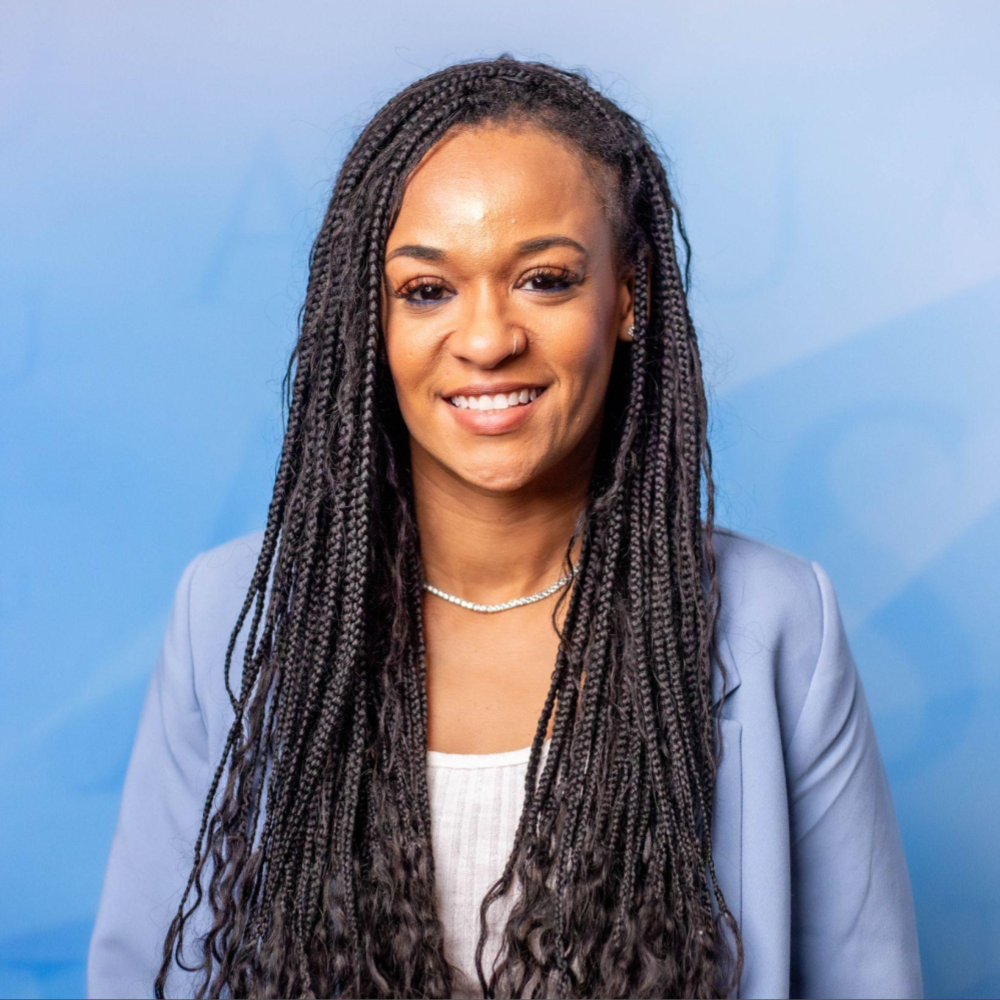
Nikki Harris, EdS, DAT, LAT, ATC, CSCS
Nicolette “Nikki” Harris serves as an Associate Professor and the Director of Student Recruitment for the Department of Athletic Training at A.T. Still University (ATSU). An alumnus of the ATSU Doctor of Athletic Training (DAT) program, Dr. Harris brings a wealth of clinical experience to her department. Prior to arriving to ATSU in 2021, she spent 6 years as the Coordinator for Athletic Training Services for Florida International University (FIU) where she worked to mature the healthcare services provided to both FIU students and campus recreation participants. In addition, she served 3 years as the Head Athletic Trainer at Miami Booker T. Washington Senior High School providing care to secondary school athletes during their pursuit of 4 State Championship Titles. In addition to her clinical practice, she has served as a Clinical Assistant Professor and Clinical Preceptor to athletic training students.
Nikki actively engages in professional service at all levels, currently sitting as the National Athletic Trainers' Association Career Advancement Committee (CAC) Chair, Co-Chair for the Educators Subgroup of the NATA Athletic Training Compensation Taskforce, the Board of Certification (BOC) Liaison to the Athletic Training Research Agenda Committee (ATRAC), the Chair for the ATSU Arizona School for Health Sciences Diversity Enrichment in Education Committee (DEEC) as well as a member of the Commission on Accreditation of Athletic Training Education (CAATE) Education Committee. Dr. Harris values the effects of research on practice and education and has demonstrated a commitment to the advancement of the athletic training profession through her scholarly work.

Kassandra Mosley, MS, LAT, ATC
Kassandra "Kassy" Mosley is currently an Assistant Athletic Trainer at East Carolina University, working with women’s tennis and women’s swimming and diving teams. Kassy’s over ten years of clinical experience includes a variety of sports at various levels of collegian athletics. Kassy is currently EdD student in Kinesiology at University of North Carolina at Greensboro and holds an MS in Movement Sciences from Barry University and a BS in Athletic Training from East Carolina University.
Kassy currently serves as the District 3 representative for the NATA Career Advancement Committee, the chair for the Mid Atlantic Athletic Trainers Association Young Professional Committee and the Mid Atlantic Athletic Trainers Association social media manager. Outside of her professional volunteer efforts, she also volunteers as a chapter advisor for the Gamma Sigma chapter of Kappa Delta Sorority where she serves as a mentor to collegian chapter members.
-
Register
- Non-member - $25
- Member - Free!
- Student - Free!
- Staff - Free!
- Certified Student - Free!
- Retired - $15
- More Information
-
Developing methods to assess the culture, climate and resiliency needs of any organization is best done using a multi-disciplinary team approach. Face-to-face interactions in the workplace and developing relationships quickly with employees can foster the trust needed for candid conversations to learn about personal and workplace concerns or issues that may lead to toxic work cultures or growth limitations. This session will also explore defining the use of the data collected for interpretation with an effective delivery of findings to an organization’s leadership with multiple options for implementation.
This presentation is a replay from COPA Con 2023, providing another opportunity to access its valuable content and insights.
Abstract:
Developing methods to assess the culture, climate and resiliency needs of any organization is best done using a multi-disciplinary team approach. Face-to-face interactions in the workplace and developing relationships quickly with employees can foster the trust needed for candid conversations to learn about personal and workplace concerns or issues that may lead to toxic work cultures or growth limitations. This session will also explore defining the use of the data collected for interpretation with an effective delivery of findings to an organization’s leadership with multiple options for implementation.Learning Objectives:
- Design a multi-disciplinary survey to address work culture, musculoskeletal injuries, mental health stressors and personal growth needs.
- Combine survey results with observational findings to develop and implement a workplace resiliency and risk mitigation program.
- Deliver data to leadership and recommendations on how to build the risk mitigation program into a work environment.
Level:
EssentialDomain(s):
Domain 1: Risk Reduction Wellness and Health Literacy
Domain 5: Health Care Administration and Professional ResponsibilityCEUs:
1.0 Category AKeywords: work culture, workplace resiliency, risk mitigation
Enhanced Access On-Demand Course Expiration:
This course will expire on December 31 at 11:59 p.m. CST and will be removed from your account if not completed.
For full details, refer to the expiration policy on our FAQ page.
Andrea Matthes Berg, DHSc, ATC, LAT
Andrea Matthes Berg DHSc, LAT, ATC is the Integrated Operational Support Program Manager for the United States Air Force.
-
Register
- Non-member - $25
- Member - Free!
- Student - Free!
- Staff - Free!
- Certified Student - Free!
- Retired - $15
- More Information
Recommended Based on Your Interests:
-
There are over 100 different physical examination tests described to evaluate the shoulder. Confusion exists with regard to not only the proper technique but the validity of commonly used tests. In today's fast paced environment evidence based accuracy and efficiency when examining athletes is very important. This presentation will review the proper technique and statistical validation, and relevance of the best tests based on current literature. The discussion will include a demonstration of an efficient sequence and algorithm incorporating all necessary tests to complete a thorough and comprehensive examination of the shoulder.
Abstract:
There are over 100 different physical examination tests described to evaluate the shoulder. Confusion exists with regard to not only the proper technique but the validity of commonly used tests. In today's fast paced environment evidence based accuracy and efficiency when examining athletes is very important. This presentation will review the proper technique and statistical validation, and relevance of the best tests based on current literature. The discussion will include a demonstration of an efficient sequence and algorithm incorporating all necessary tests to complete a thorough and comprehensive examination of the shoulder.
Objectives:- Participants will be able to describe the history and proper indications for the most commonly used shoulder exam tests.,
- Participants will be able to explain basic statistical terms (i.e., sensitivity, specificity, diagnostic accuracy) to describe the validity of physical exam tests.,
- Participants will be able to describe the proper technique for performing shoulder exam tests.
Level:
Advanced
Domains:
Domain 2: Assessment Evaluation and DiagnosisCEUs:
0.75 Category AKeywords: shoulder, examination, tests, diagnostic, pitching, throwing,
On-Demand (Enhanced Access) Course Expiration:
Courses registered for after February 5, 2025, must be completed by December 31, 2025, at 11:59 p.m. CST.
For full details, refer to the expiration policy on our FAQ page.Please note: This course will be retired from our catalog after December 31, 2025, and its content will no longer be accessible. Be sure to download any necessary handouts before this date. Your statement of credit will remain available on the Transcript page, accessible via the left sidebar menu.
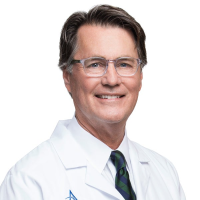
Steve Jordan, MD
Dr. Steve Jordan is a board certified, fellowship trained orthopaedic surgeon. Dr. Jordan earned his Medical Degree from Medical University of South Carolina. Dr. Jordan specializes in sports medicine; however, he takes a special interest in shoulder injuries, throwing injuries, ACL reconstruction, and Tommy John reconstruction. Dr. Jordan is the Team Physician for both Washington High School and Chipola College.
-
Register
- Non-member - $18.75
- Member - Free!
- Student - Free!
- Staff - Free!
- Certified Student - Free!
- Retired - $11.25
- More Information
-
History of prior injury is the strongest risk factor for future lower extremity injury. In addition, a large portion of secondary injuries occur during the first 2-3 months following return to sport. Thus, there is a gap in determining when an individual is ready to safely return to sport following initial injury. Individuals who pass a comprehensive return to sport testing battery are at lower risk for subsequent injury once returning to sport. As such, the development and utilization of a comprehensive return-to-sport testing battery can help determine one´s readiness to safely return to sport. This presentation will discuss the key components of…
This presentation is a replay from NATA 2019 in Las Vegas, offering a second chance to experience the event's valuable content and insights.
Abstract:
History of prior injury is the strongest risk factor for future lower extremity injury. In addition, a large portion of secondary injuries occur during the first 2-3 months following return to sport. Thus, there is a gap in determining when an individual is ready to safely return to sport following initial injury. Individuals who pass a comprehensive return to sport testing battery are at lower risk for subsequent injury once returning to sport. As such, the development and utilization of a comprehensive return-to-sport testing battery can help determine one´s readiness to safely return to sport. This presentation will discuss the key components of an evidence-based return to sport testing battery following lower extremity injuries.
Objectives:- Participants will be able to describe the changes in injury rates following initial lower extremity injury and subsequent return to sport.,
- Participants will be able to describe the known risk factors for secondary injury following initial lower extremity injury.,
- Participants will be able to utilize validated return to sport testing that can determine an individual´s readiness to return to sport.,
- Participants will be able to discuss the role of training load monitoring and management in the return to sport process following lower extremity injury.
Level:
Advanced
Domains:
Domain 1: Risk Reduction Wellness and Health Literacy, Domain 2: Assessment Evaluation and DiagnosisCEUs: 1.0 Category A
Keywords: knee, injury, lower extremity, return to sport, ankle, leg, testing
On-Demand (Enhanced Access) Course Expiration:
Courses registered for after February 5, 2025, must be completed by December 31, 2025, at 11:59 p.m. CST.
For full details, refer to the expiration policy on our FAQ page.
Darin Padua, PhD, ATC
Darin A. Padua is the Associate Provost for Academic Operations of the University of North Carolina at Chapel Hill. As an academic leader, he works to listen, collaborate, and empower others to work as a team towards our shared mission, vision, and priorities.
The Joseph Curtis Sloane Distinguished Professor of Exercise and Sport Science, Padua has been a member of UNC’s faculty since 2001. He teaches courses in biomechanics, human anatomy, and kinesiology with a focus on injury risk mitigation and optimizing human performance. Throughout his career, Padua has mentored fellow faculty, along with hundreds of graduate and undergraduate students. He served as chair in the Department of Exercise and Sport Science from 2013 to 2023.
With more than 25 years of experience, Padua is an internationally recognized scholar and is the Co-Director of the Musculoskeletal Injury Prevention (MOTION) Science Institute. His research revolves around prevention of musculoskeletal injuries, such as ACL rupture, by studying the role of movement quality and biomechanics as injury risk factors and intervention targets. He has published over 200 peer-reviewed articles, and his work has been funded by the National Institutes of Health, the National Athletic Trainers’ Association, and the American Orthopaedic Society for Sports Medicine. He
He received the Young Investigator Award by the National Athletic Trainers’ Association (2006) and was later awarded the O’Donoghue Sports Injury Research Award for the most outstanding sport injury related research paper by the American Orthopaedic Society for Sports Medicine (2008). He attained Fellow status in the National Academy of Kinesiology, the National Athletic Trainers’ Association, and received the Most Distinguished Athletic Trainer Award. His career research achievements were recognized by the by the National Athletic Trainers’ Association with receipt of the Medal for Distinguished Research (2017).
Padua earned a B.S. in athletic training from San Diego State University, M.A. in exercise and sport science/athletic training from the University of North Carolina at Chapel Hill, and PhD in sports medicine from the University of Virginia. Born and raised in Visalia, California, he lives with his wife Jody and three daughters in Durham, NC.
-
Register
- Non-member - $25
- Member - Free!
- Student - Free!
- Staff - Free!
- Certified Student - Free!
- Retired - $15
- More Information
-
Knee pathologies are common complaints for athletes and active patients presenting to athletic trainers for assessment and intervention, and though often not as complex as other joints in the body (ie, shoulder or hip), can present significant diagnostic challenges when imaging techniques are not readily or immediately available. Common traumatic disorders of the knee include forces that impact the menisci, ligaments, bones, and associated joints (ie, patellofemoral, tibiofemoral), while overuse injuries involving the patellofemoral joint, surrounding tissues (ie, IT Band), patellar tendon and tibiofemoral joint can challenge the unsuspecting diagnostician, as well. Undiagnosed, or improperly diagnosed knee conditions can also lead to lifelong disability and/or profound decreases in…
Abstract:
Knee pathologies are common complaints for athletes and active patients presenting to athletic trainers for assessment and intervention, and though often not as complex as other joints in the body (ie, shoulder or hip), can present significant diagnostic challenges when imaging techniques are not readily or immediately available. Common traumatic disorders of the knee include forces that impact the menisci, ligaments, bones, and associated joints (ie, patellofemoral, tibiofemoral), while overuse injuries involving the patellofemoral joint, surrounding tissues (ie, IT Band), patellar tendon and tibiofemoral joint can challenge the unsuspecting diagnostician, as well. Undiagnosed, or improperly diagnosed knee conditions can also lead to lifelong disability and/or profound decreases in health-related quality of life and functional enjoyment. Unsuspecting or inexperienced clinicians in all branches of sports medicine, if not careful can naively rely on special test results in isolation, or upon medical imaging for a working or final diagnosis, which includes false positive and negative results, increases overall healthcare costs, and/or cause unnecessary delays in treatment or return to participation. Experts in medical research have confirmed that accurate diagnoses come from the history portion of the exam in over 80 to 90% of cases and that individual physical exam test results should be viewed with suspicion in isolation. The focus of this presentation is to present the athletic training profession a review of physical examination special tests for common knee injuries and conditions, while also introducing or reviewing the evidence behind each test's respective diagnostic accuracy. In so doing, an overview of diagnostic accuracy terms and principles will be presented, followed by available diagnostic accuracy dates for each test presented in order for clinicians to become more aware of the strengths and limitations of tests commonly used to help assess athletic injuries of the knee.
Objectives:
- Participants will be able to state the fundamental principles and terms associated with diagnostic accuracy of physical examination tests, including sensitivity and specificity, positive and negative likelihood ratios, positive and negative predictive values, and overall utility scores.,
- Participants will be able to identify the most useful, evidence-based physical examination tests for assessing various conditions of the knee.,
- Participants will be able to recognize and incorporate the best-evidence tests in times of acute and chronic assessment of common knee injuries.,
- Participants will be able to apply use of pooled tests in order to more accurately assess various orthopedic conditions of the knee in athletes and active patients.
Level:
Advanced
Domains:
Domain 2: Assessment Evaluation and DiagnosisCEUs:
1.25 Category AKeywords: knee, orthopedic, menisci, ligaments, bones, joints, patellofemoral, tibiofemoral
On-Demand (Enhanced Access) Course Expiration:
Courses registered for after February 5, 2025, must be completed by December 31, 2025, at 11:59 p.m. CST.
For full details, refer to the expiration policy on our FAQ page.
Paul Geisler, EdD, AT Ret.
Associate Dean Geisler is a native of Lakeville, MA and current resident of Boston, MA. A certified athletic trainer since 1987 with over 15 years of varied clinical practice and 23 years' experience directing athletic training education programs at Georgia Southern University and Ithaca College. He is deeply interested in the development and assessment of the medico-clinical thinking processes of novice and experienced clinicians, the development of adaptive expertise in clinicians, progressive curriculum design, capability-based education, and meaningful programmatic assessment. He has over 170 national and international presentations and publications on clinical and educational based subjects in athletic training and health professions education to his credit. He is a member of the European Board of Medical Assessors, and past member of the Association of Medical Education, Europe.
As a scholar, he is the recipient of two manuscript awards from the Journal of Athletic Training and the Athletic Training Education Journal. For his many professional contributions, he has been the recipient of the NATA Athletic Training Service Award and NATA Most Distinguished Athletic Trainer Award. As an educator, he was awarded the NATA Executive Council on Education's Sayers "Bud" Miller Distinguished Educator Award in 2021 and has received two Dean's Awards for Excellence & Innovation in Teaching, a Dean's Excellence Award for Diversity and Inclusion in Teaching and Learning, and the all college Faculty Excellence Award, all from Ithaca College.
He admits to being an enthusiastic but slow road cyclist, an amateur shutterbug of nature and wonder, an aspiring wine snob and amateur foodie, and an unabashed promoter of equal rights, freedom, justice, and authentic democracy for all living beings. Susan, his life partner and wife of 34 years and he are fulfilled parents of two amazing young men – Nicholas, a writer living in Los Angeles, CA and Benjamin, a photographer and artist living in Brooklyn, NY.
-
Register
- Non-member - $31.25
- Member - Free!
- Student - Free!
- Staff - Free!
- Certified Student - Free!
- Retired - $18.75
- More Information
-
The focus of this presentation is to present the most current clinical recognition strategies for evaluating ankle sprains and linking these strategies to the identification of those who are at the highest risk for developing CAI.
Abstract:
The focus of this presentation is to present the most current clinical recognition strategies for evaluating ankle sprains and linking these strategies to the identification of those who are at the highest risk for developing CAI.
Objectives:- Participants will be able to summarize the recommendations of the NATA Position Statement on the Conservative Management and Prevention of Ankle Sprains in Athletes within the context of Clinical Evaluation and Diagnosis.,
- Participants will be able to identify the most important evidence-based key features associated with lateral ankle sprain recognition.,
- Participants will be able to incorporate the emerging evidence of patient- and clinician-oriented outcome measures for identifying those at risk for developing chronic ankle instability.,
- Participants will be able to make use of the outcome measures discussed in the presentation, including the Foot and Ankle Ability Measure, the Cumberland Ankle Instability Tool, the weight-bearing lunge test, the single limb balance test, and the star excursion balance test, within their clinical practice.
Level:
Advanced
Domains:
Domain 2: Assessment Evaluation and DiagnosisCEUs:
1.0 Category AKeywords: ankle, sprain, instability, diagnosis, lateral ankle sprain, balance test
On-Demand (Enhanced Access) Course Expiration:
Courses registered for after February 5, 2025, must be completed by December 31, 2025, at 11:59 p.m. CST.
For full details, refer to the expiration policy on our FAQ page.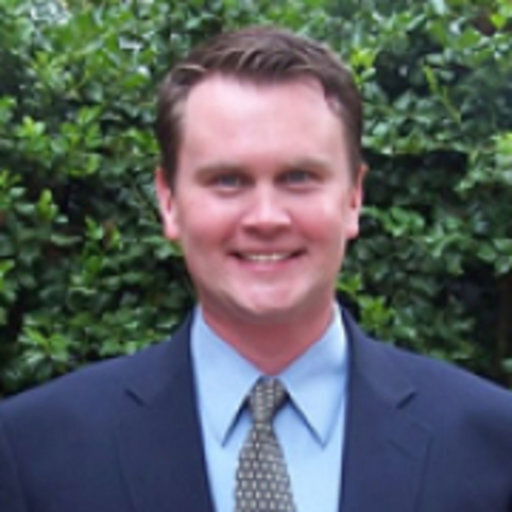
Patrick McKeon, PhD, ATC, CSCS
Dr. Patrick McKeon is a BOC certified athletic trainer who joined the Ithaca College Athletic Training faculty in 2013. He received his Bachelor of Science degree in Athletic Training from Springfield College in Springfield, MA; his Master of Science degree in Sports Health Care from the Arizona School of Health Sciences in Phoenix, AZ (now in Mesa, AZ); and his PhD in Sports Medicine at the University of Virginia in Charlottesville. He has held several positions as a clinical athletic trainer including Pearl River High School, Canisius College, and Marist College in New York, as well as Phoenix College and Brophy College Preparatory in Arizona.
SCHOLARLY/RESEARCH INTERESTS
Dr. McKeon’s research focuses on functional alterations associated with lower extremity joint injury. He incorporates patient-, clinician-, and laboratory-oriented outcomes to evaluate these alterations due to injury. Dr. McKeon also seeks to develop a greater understanding of the restoration of function associated with rehabilitation. He aims to provide insight into effective clinical interventions for the sports medicine clinician to improve functional outcomes and enhance prevention strategies for patients who suffer lower extremity injury.EDUCATIONAL INTERESTS
Dr. McKeon's educational focus centers on evidence-based practice concepts and clinical reasoning theory. Within the courses he teaches, Dr. McKeon strives to instill a strong foundation in the integration of internal and external evidence for enhancing decisions related to the recognition, rehabilitation, and prevention of injuries/illnesses associated with athletic training clinical practice.PERSONAL
Dr. McKeon enjoys spending his free time with his family and friends seeking out great life experiences. His wife, Dr. Jennifer McKeon is the IC Athletic Training Program Director and a faculty member in the Department of Exercise Science and Athletic Training. They have two children (Bobby and Mallory) who are also proud to be Bombers!-
Register
- Non-member - $25
- Member - Free!
- Student - Free!
- Staff - Free!
- Certified Student - Free!
- Retired - $15
- More Information
| Access Date | Quiz Result | Score | Actions |
|---|
Please Login
Announcement
New Expiration Date Policy for Enhanced Access On-Demand Courses
Effective February 5, 2025, all courses in our Enhanced Access On-Demand Catalog will expire on December 31 at 11:59 p.m. CST. Visit our FAQ page for details on this new policy and instructions on creating a Favorites List to save courses for future years.

